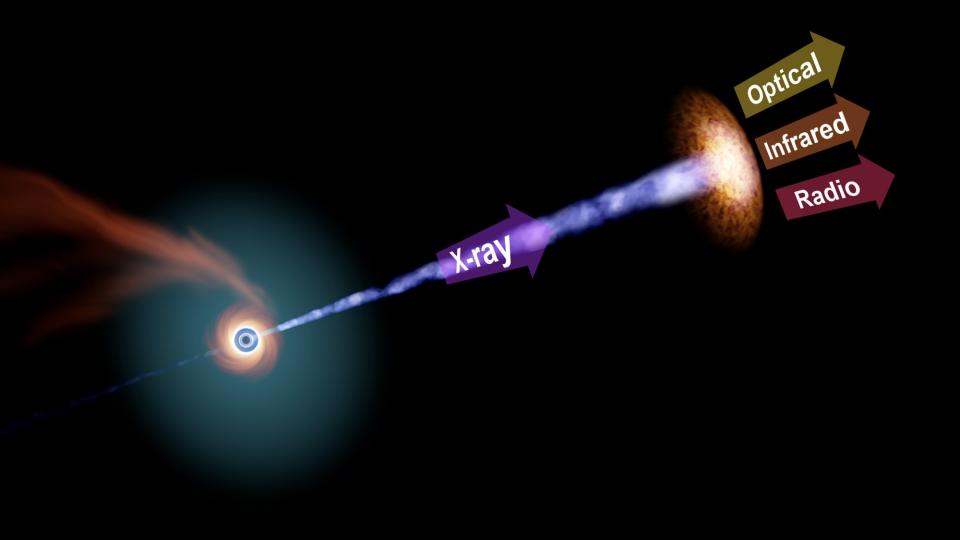It’s a cosmic jungle for stars that venture too close to black holes. A team from the Massachusetts Institute of Technology has found 18 new examples of black holes tearing stars apart and feasting on their remains.
This result more than doubles the number of horrific, star-crushing Tidal Disruption Events (TDEs) observed in the local universe. The findings could help astronomers better estimate the number of TDEs occurring throughout the universe, bringing the rate closer to theoretical predictions.
TDEs occur when a star comes too close to a black hole, and the latter object’s gravitational influence generates tidal forces in the star so great that the star’s body is stretched vertically while it is squashed horizontally, a process called ‘spaghettification’ .
The star’s material forms a flattened disk around the black hole, some of which ends up at the heart of the black hole, while other material is channeled toward the poles by powerful magnetic fields and shot out as near-light jets.
Related: Black hole is shredding stars in a cosmic feeding frenzy that has astronomers excited
Previously, astronomers believed that black holes tear apart and devour stars, expelling highly energetic jets into galaxies that have recently undergone periods of intense star birth, called “starbursts.”
However, this research implies that TDEs could occur in a larger number of galaxies and help explain the extreme physics surrounding such events.
“People came up with very exotic solutions to these puzzles, and now we’re at the point where we can solve them all,” Erin Kara, team member and assistant professor of physics at MIT, said in a statement.
How the hunt for Tidal Disruption Event began
The MIT team began searching for more star-devouring black holes after discovering the closest TDE to Earth ever seen. It was observed in the form of an outburst from the galaxy NGC 7392, located about 137 million light-years from Earth.
This opened up a whole new way to spot actively feeding black holes, they said. It involves the use of infrared light and an algorithm that looks for patterns in infrared data that indicate short or ‘transient’ bursts of radiation. The completed technique was based on historical data collected by NASA’s Wide-field Infrared Survey Explorer (NEOWISE). Since its launch in 2009, NEOWISE has been searching the skies above Earth for short bursts of infrared light.
The team then compared the transients they found to a catalog of galaxies within 600 million light-years of Earth, showing that the infrared bursts could be traced back to about 1,000 galaxies.
By zooming in on these galaxies, the researchers tried to discover whether the signals they detected came from TDEs or whether they could have been caused by other violent events, such as the supernova explosion of a massive dying star. It would also have been possible that they came from supermassive black holes at the hearts of galaxies, feeding on falling dust and gas.

This ultimately led to the discovery of 18 legitimate TDE signals that resulted from the gravitational influence of black holes generating tidal forces in stars that ultimately led to some gory deaths.
Surprisingly, the team found that TDEs appear to occur in a range of galaxies across the sky, including galaxies filled with thick dust clouds.
“If you were to look at the sky and see a number of galaxies, the TDEs would be representative in all of them,” said Megan Masterson, lead author of the study and a graduate student at MIT’s Kavli Institute for Astrophysics and Space Research.
Hiding cosmic crimes
In the big picture, this research helps resolve some important questions surrounding tidal disturbances.
Previously, astronomers had mainly seen these star-busting events in post-starburst galaxies with stellar factories that had recently closed.
Such galaxies are quite rare, and scientists were confused as to why TDEs seemed limited to them. This study clears up that confusion by finding bloody TDEs in a range of galaxy types.
The reason TDEs were seemingly absent in other galaxies is that while post-starburst galaxies are devoid of thick gas and dust because they have depleted the materials while creating a wealth of new stars, other galaxies still have the material in abundance have. Gas and dust are adept at absorbing or blocking optical and X-ray light, but infrared slips through them more easily.
So X-ray and optical emissions were well suited for detecting TDEs in dust-poor galaxies, but infrared observations were crucial for finding star-chopping black holes in dusty galaxies.
“It’s not that they only exist in one type of galaxy, as people thought based on optical and X-ray studies,” Masterson added. “If you want to understand TDEs as a whole and use them to investigate the demographics of supermassive black holes, you need to look in the infrared band.”
Related stories:
— Black hole announces itself to astronomers by violently tearing apart a star
– Record breaker! The newly discovered black hole is closest to Earth
— NASA X-ray observatory shows how black holes swallow stars and spit out matter
The MIT researchers’ findings could also explain why TDEs do not appear to emit as much energy as predicted by theory, with the team suggesting that the energy deficit is due to dust absorbing optical and X-ray radiation, as well as extreme ultraviolet radiation from TDEs.
Adding the 18 new TDEs they discovered to previously observed events of this nature, the MIT team estimates that galaxies experience a TDE about once every 50,000 years, which is in line with previous theoretical predictions.
“This gives us confidence that we don’t need all this exotic physics to explain what we see,” Kara concluded. “And we have a better understanding of the mechanisms behind how a star is torn apart and swallowed by a black hole. We understand these systems better.”
The team’s research was published Monday (Jan. 29) in the Astrophysical Journal.